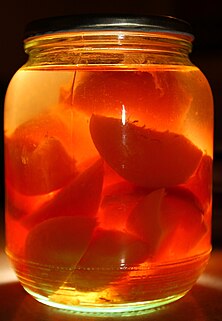Kompot
 Traditional Bulgarian kompot | |
| Alternative names | Compot |
|---|---|
| Type | Food |
| Place of origin | Europe; primarily Eastern and Balkans |
| Serving temperature | Cold, hot, or room temperature |
| Main ingredients | Various fruit |
| Variations | Uzvar |
Kompot or compote is a non-alcoholic sweet beverage that may be served hot or cold, depending on tradition and season. It is obtained by cooking fruit such as strawberries, apricots, peaches, apples, raspberries, rhubarb, plums, or sour cherries in a large volume of water, often together with sugar or raisins as additional sweeteners. Sometimes different spices such as vanilla or cinnamon are added for additional flavour, especially in winter when kompot is usually served hot. Kompot is popular in Central and Eastern European countries as well as in Southern Europe.
Kompot[]
Kompot is part of the culinary cultures of many countries in Central, Eastern, Southern Europe and Middle East, such as: Bulgaria, Armenia, Albania, Azerbaijan, Belarus, Ukraine, Russia, Poland, Bosnia and Herzegovina, Lithuania, Latvia, Estonia, Hungary, Slovakia, Slovenia, Croatia, North Macedonia, Serbia, Montenegro, Moldova and Romania (where it is known as compot), Austria, Greece, Georgia , Cyprus and Turkey. Kompot (компот in: Bulgarian, Russian, Serbian, Bosnian, Macedonian and Ukrainian; Komposto in Turkish[1][2][3]) was a widely used way of preserving fruit for the winter season in Southern and Eastern European countries. In 1885, Lucyna Ćwierczakiewiczowa wrote in a recipe book that kompot preserved fruit so well it seemed fresh.[4] Kompot was still popular in the 1970s. It is also popular in many Central Asian countries, such as Uzbekistan and Kyrgyzstan.[5]
The consumption of kompot has been declining since the 1980s. With the end of food preservation in many countries of South and Eastern Europe, kompot has been supplanted by fruit juice, soft drinks and mineral water.[6]
Uzvar[]
Uzvar or vzvar is a similar Ukrainian drink, prepared from various dried fruit and sometimes berries, sweetened with honey or sugar, popular in Ukraine.
See also[]
Notes and references[]
- ^ https://arpacbahsismtal.meb.k12.tr/meb_iys_dosyalar/33/05/974043/dosyalar/2017_10/19221440_tYrk_mutfaYnda_komposto_ve_hoYaflar_07.pdf
- ^ "Dünya mutfağında komposto".
- ^ "Turkish Food & Recipes".
- ^ Lucyna Ćwierczakiewiczowa, Jedyne praktyczne przepisy konfitur, różnych marynat, wędlin, wódek, likierów, win owocowych, miodów oraz ciast
- ^ Berger, Stanisław (2005). Kuchnia Polska (in Polish) (XLVII ed.). Warszawa: Państwowe Wydawnictwo Ekonomiczne, then rebranded into Polskie Wydawnictwo Ekonomiczne. ISBN 83-208-1556-8.
- ^ Viviane Bourdon, Savoureuse Pologne, 160 recettes culinaires et leur histoire, Paris, La Librairie polonaise, les éditions Noir sur Blanc, 2006
External links[]
- Desserts
- Fruit dishes
- Bosnia and Herzegovina cuisine
- Bulgarian cuisine
- Croatian cuisine
- Czech cuisine
- Polish drinks
- Polish cuisine
- Russian cuisine
- Slavic cuisine
- Ukrainian cuisine
- Hungarian cuisine
- Serbian cuisine
- Slovenian cuisine
- Romanian cuisine
- Moldovan cuisine
- Soviet cuisine
- Kazakh drinks
- Montenegrin cuisine
- Turkish cuisine